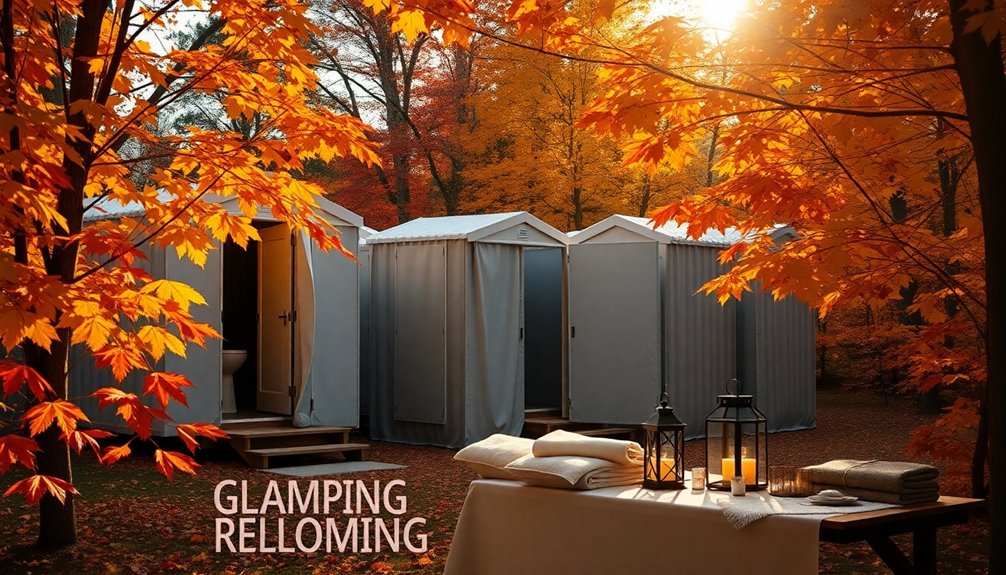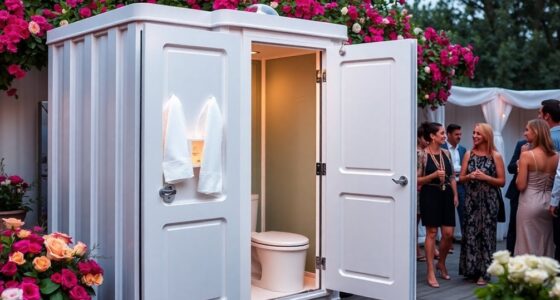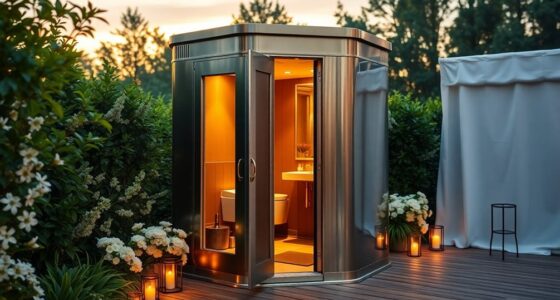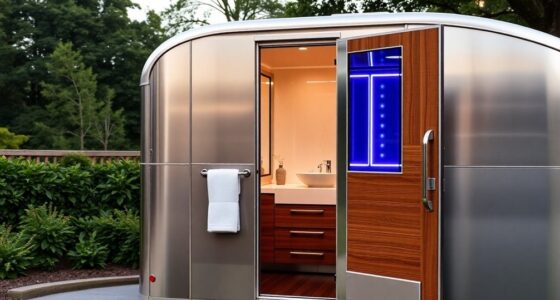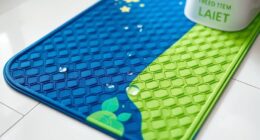To prepare your glamping portable restrooms for changing weather, conduct risk assessments for heavy rain, snow, and extreme heat. Place units on elevated ground and choose stable surfaces like gravel. Secure them in wind-protected areas with anchors and regularly inspect for stability. Insulate restroom units with foam or wraps and use non-toxic antifreeze to prevent freezing. Finally, maintain a consistent cleaning schedule to guarantee functionality. Discover strategies to enhance your setup further as you continue exploring.
Key Takeaways
- Conduct thorough risk assessments for heavy rain, snow, and extreme heat to ensure proper placement and maintenance of portable restrooms.
- Elevate units on sturdy surfaces like gravel or concrete to prevent flooding and ensure stability during changing weather conditions.
- Insulate portable restrooms with spray foam or winter wraps, and use non-toxic antifreeze to protect waste tanks from freezing temperatures.
- Regularly inspect and maintain securing mechanisms, especially before predicted high winds, to prevent tipping or damage.
- Schedule frequent cleaning and sanitizing services, adjusting based on weather conditions and usage to ensure a welcoming environment for guests.
Common Weather Challenges for Glamping Portable Restrooms
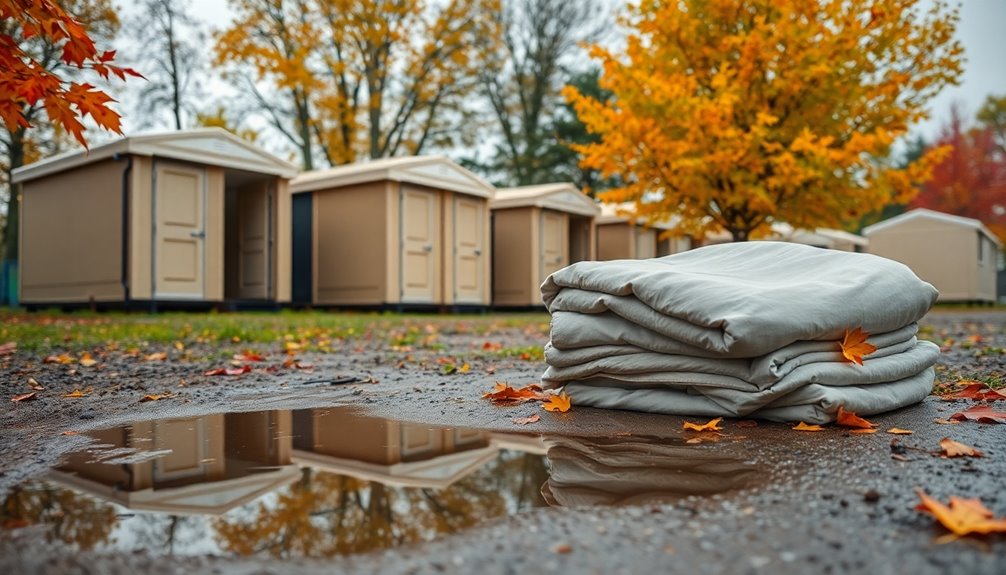
When it comes to glamping, how can you guarantee your portable restrooms stand up to the elements? First, understand that weather challenges can vary considerably.
Heavy rain can lead to flooding; make sure to place your portable toilet rentals on elevated ground to prevent instability. In colder months, temperatures below 20°F might cause waste tanks to freeze, so use antifreeze solutions and insulation to prevent freezing.
High winds pose another risk—securely anchor restrooms to avoid tipping during storms. Additionally, regular maintenance is essential during changing weather to prevent overflows and guarantee sanitation, particularly in high-traffic areas.
Risk Assessment for Different Weather Conditions
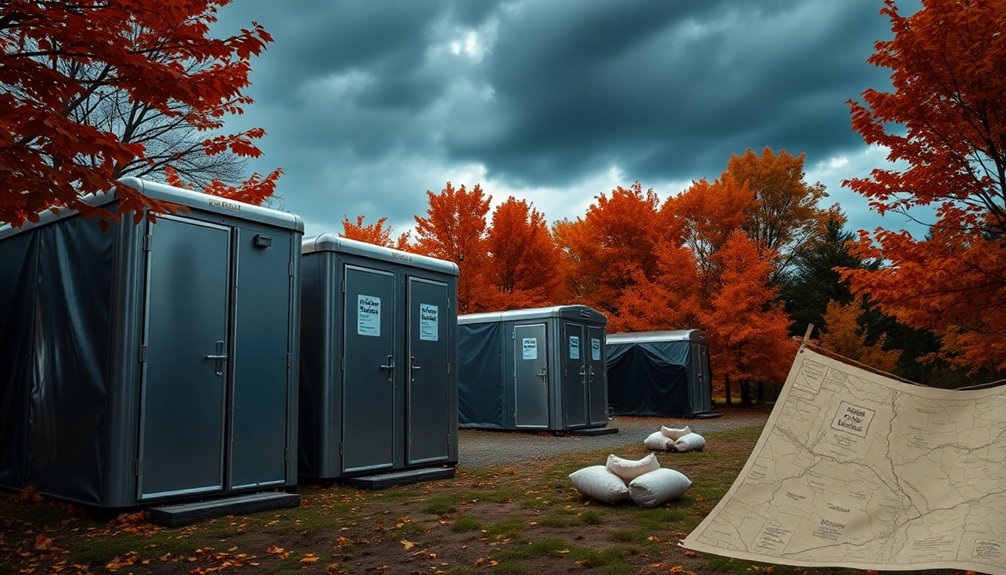
To guarantee your glamping portable restrooms remain functional and safe, evaluating risks associated with various weather conditions is essential. Conducting a thorough risk assessment for different weather conditions, including rain, snow, and extreme heat, helps identify vulnerabilities in both placement and functionality.
For instance, knowing portable toilets can freeze at temperatures below 20°F highlights the importance of preventing freezing through insulation and antifreeze solutions. Regular inspections during harsh weather ascertain waste levels are monitored to prevent overflows and unpleasant odors.
Additionally, proper placement in sheltered areas minimizes damage from strong winds and flooding. By implementing effective maintenance protocols, including frequent servicing and securing units against tipping, you can ascertain user comfort and restroom functionality amid changing weather conditions.
Identifying Wind-Protected Areas for Placement

Finding wind-protected areas for your glamping portable restrooms is essential for ensuring stability and comfort. Look for spots shielded by trees or hills to reduce the risk of tipping during strong winds. Elevated ground can also offer protection against flooding and gusts.
- Enhance user experience by providing a calm environment.
- Avoid the embarrassment of restroom mishaps during an outdoor event.
- Create a welcoming atmosphere for your guests.
Consider using temporary windbreaks like tarps or plywood barriers in exposed areas.
Analyze historical weather data to choose locations that minimize exposure to strong winds. Regularly monitor and adjust the positioning of your portable restrooms based on changing weather conditions to maintain that vital protection from the elements. Additionally, healthy ecosystems provide essential services that can enhance the overall glamping experience for your guests.
Ground Surface Considerations for Stability
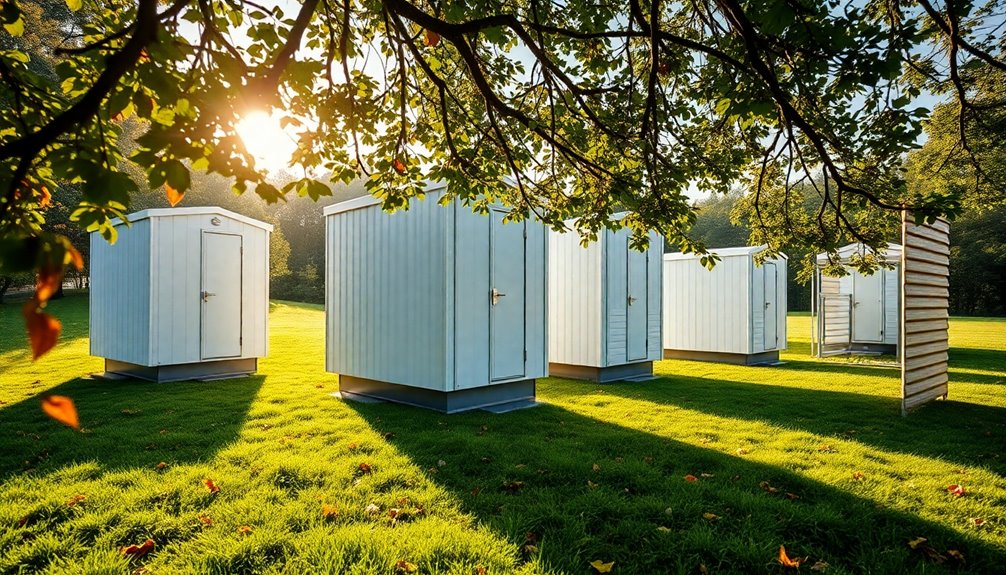
When you're choosing a ground surface for portable restrooms, opt for sturdy options like gravel or concrete to keep them stable.
Elevating the units can also help prevent flooding in wet conditions.
Don't forget to take into account drainage solutions to enhance traction and guarantee easy access, especially after heavy rain.
Surface Type Selection
Selecting the right ground surface is essential for guaranteeing the stability of portable restrooms, especially during unpredictable weather. A proper surface type selection can make all the difference in maintaining a secure and safe environment.
- Prevent mud and muck from causing disasters.
- Guarantee your guests feel safe using the facilities.
- Keep your investment in portable restrooms protected.
Opt for sturdy surfaces like gravel or compact dirt to create a stable base. Avoid soft, muddy, or sandy grounds that can lead to sinking or tilting.
Wooden platforms or mats can enhance stability and accessibility, guaranteeing your units remain upright even in adverse conditions. Additionally, using natural elements in your setup can promote a calming atmosphere for guests while ensuring practical functionality.
Prioritizing ground surface selection not only secures the restrooms but also promotes user safety during challenging weather.
Elevation and Drainage
After guaranteeing a proper ground surface for your portable restrooms, the next step is focusing on elevation and drainage to maintain their stability.
Elevating the units on sturdy surfaces helps prevent toppling during heavy rain and guarantees they stand firm in windy conditions. Choosing high ground minimizes the risk of flooding, which could compromise functionality.
Surrounding the restrooms with drainage mats effectively channels water away, reducing mud accumulation and enhancing user safety. You'll want to avoid placing them in low-lying or muddy areas, as these can lead to instability and accessibility issues during bad weather.
Opting for strategic surfaces like gravel or concrete pads provides a secure footing, further reducing the likelihood of movement in inclement conditions. Additionally, installing portable camping toilets ensures that users have access to essential facilities, even in adverse weather.
Stability Reinforcement Techniques
To guarantee your portable restrooms remain stable during changing weather conditions, it's crucial to implement effective reinforcement techniques. Choosing sturdy surfaces like gravel or concrete enhances stability and minimizes the risk of toppling during heavy rain.
Elevating your portable toilets on platforms can prevent flooding, ensuring functionality even during snowmelt.
Consider these emotional factors to reinforce your commitment:
- Comfort and safety for your guests
- Peace of mind, knowing your facilities are secure
- Avoiding costly repairs or replacements
Using anchoring systems, such as stakes or bolts, secures your units against high winds.
Additionally, regular inspections of the ground surface prevent erosion and maintain stability, keeping your restrooms accessible and reliable. Ensuring proper airflow around the unit is also essential for preventing moisture buildup and promoting a healthy environment for users.
Flood Risk Assessment and Prevention Strategies
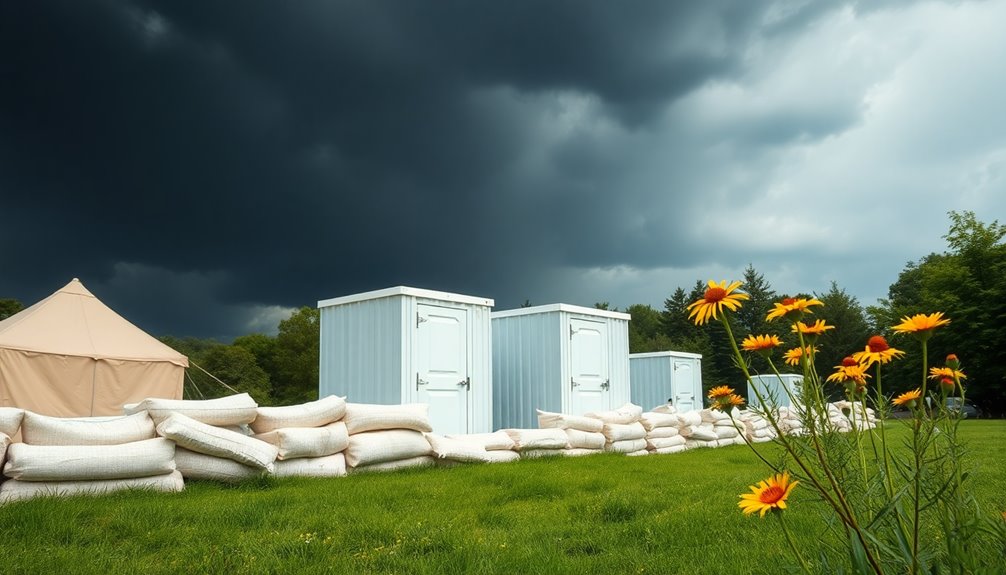
As you plan for the installation of glamping portable restrooms, conducting a thorough flood risk assessment is essential. Start by evaluating local topography and proximity to water sources to pinpoint potential flooding zones. Position restrooms on elevated ground and away from low-lying areas to prevent flooding during heavy rainfall. Implement drainage systems to divert excess water and utilize waterproof coverings to protect against moisture.
| Action | Purpose | Frequency |
|---|---|---|
| Conduct flood risk assessment | Identify potential flooding zones | Before installation |
| Regular inspections | Address flooding issues promptly | After heavy rains |
| Install drainage systems | Divert water away | As needed |
| Use waterproof coverings | Protect from rain | Before wet seasons |
Essential Winterization Techniques for Portable Restrooms

When winter hits, you'll want to guarantee your portable restrooms are ready for the cold.
Start by insulating the units and using effective antifreeze solutions to prevent freezing issues.
Don't forget to stick to a regular maintenance and cleaning schedule to keep everything functioning smoothly. Additionally, consider incorporating multi-functional gear to efficiently manage limited space within the restrooms.
Insulation Methods for Toilets
Insulating portable restrooms is essential for maintaining functionality during winter months, especially in regions prone to freezing temperatures. Effective insulation methods can greatly reduce the risk of freezing, guaranteeing a comfortable experience for users.
- Keep your guests happy and warm!
- Prevent waste from freezing and causing unpleasant backups.
- Ascertain your facilities are always ready for use.
Using materials like spray foam or specialized winter wraps helps maintain a stable internal temperature. Covering units with tarps prevents snow and ice from entering.
Additionally, adding non-toxic anti-freeze to waste tanks protects against freezing. Don't forget regular maintenance checks to verify insulation effectiveness and catch any issues early on.
Implementing Leave No Trace principles during winter usage also helps in minimizing environmental impact.
With these strategies, your portable restrooms can withstand the winter chill!
Effective Antifreeze Solutions
Winterizing portable restrooms is essential to guarantee they remain functional and comfortable, even in harsh conditions.
To ensure proper operation during winter, consider using effective antifreeze solutions like non-toxic brine or magnesium chloride, which can maintain functionality in temperatures as low as -20°F.
Regularly emptying the tanks helps prevent freezing and blockages, so stick to a frequent waste management schedule.
Applying rock salt around the base can also prevent freezing, especially in temperatures around 0°F; aim for 2 pounds of salt per gallon of waste for ideal protection.
Additionally, insulating restrooms with thermal covers or tarps can help maintain a cozy environment, keeping users satisfied even in cold weather.
Maintenance and Cleaning Schedule
To guarantee portable restrooms remain functional and hygienic throughout the winter, establishing a diligent maintenance and cleaning schedule is essential.
Start by winterizing portable restrooms—completely empty and clean the tanks, then add a non-toxic antifreeze solution to prevent freezing. Schedule regular cleaning and sanitizing services at least weekly during peak usage times.
- Prevent unpleasant surprises for your guests.
- Maintain a clean, welcoming environment.
- Provide peace of mind during busy events.
Additionally, inspect insulation and coverings to prevent ice buildup.
Monitor usage closely, adjusting your cleaning frequency based on severe weather conditions.
Antifreeze Solutions and Their Applications
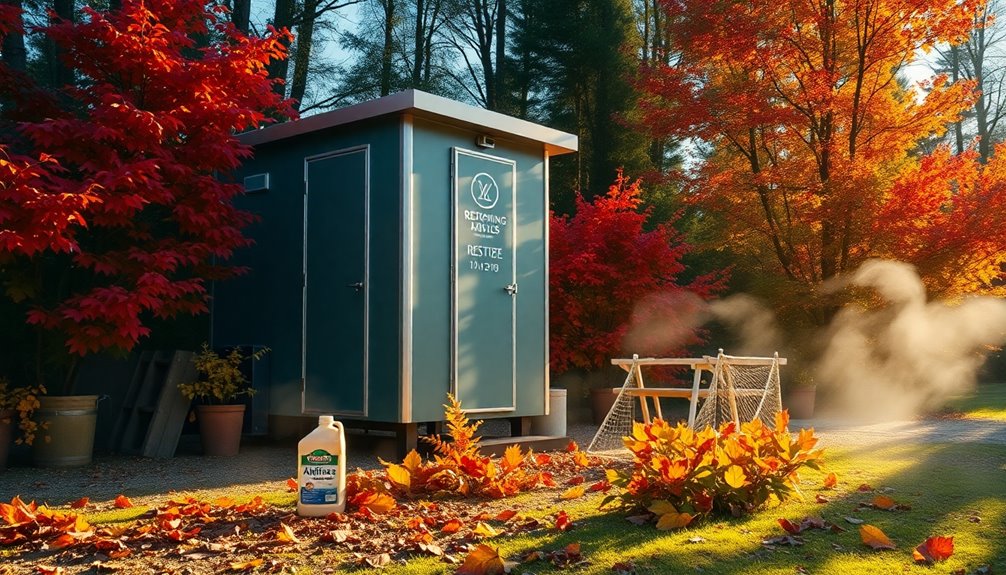
As temperatures drop, ensuring your portable restrooms remain functional becomes vital, especially when facing extreme cold.
To prevent waste from freezing, consider using non-toxic antifreeze solutions. Methanol can effectively protect against severe cold, but handle it carefully due to its flammability.
Brine solutions are another option, as they lower the freezing point of water, helping to keep your units operational. Magnesium chloride is particularly useful, providing freeze protection down to about -20°F.
Remember, the proper application of these antifreeze solutions is important; ensuring the correct mixing ratios will enhance safety and effectiveness.
Insulation Methods to Combat Cold Weather
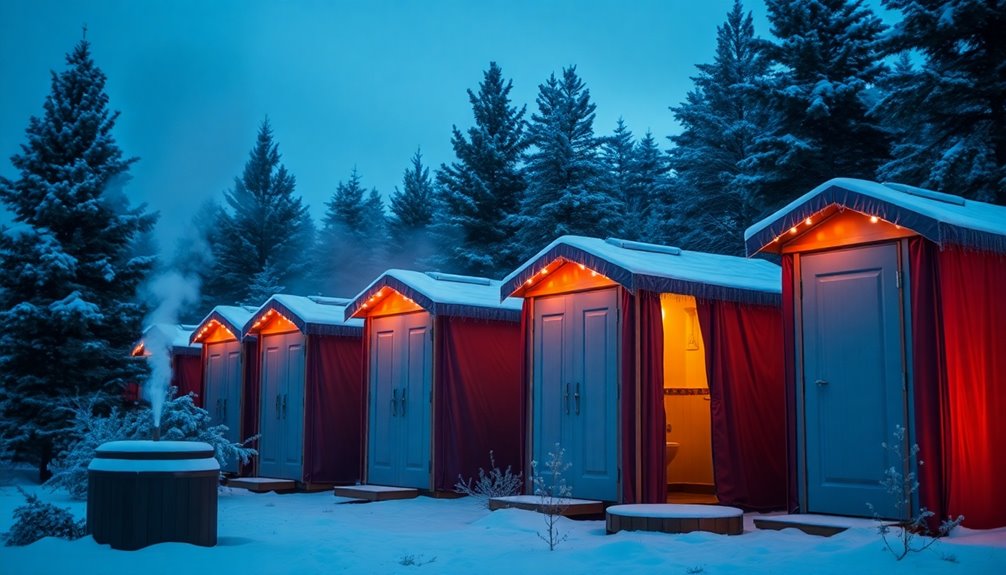
When temperatures drop, effective insulation methods are vital for maintaining the functionality of glamping portable restrooms. Utilizing spray foam or winter wrapping systems markedly reduces freezing risks, even in temperatures below 20°F (-6°C).
You can enhance comfort by using thermal covers and tarps to trap heat inside and keep snow and ice out.
- Guarantee a cozy experience for your guests
- Provide peace of mind during cold spells
- Maintain operational efficiency with ease
Adding non-toxic antifreeze solutions to the holding tanks prevents sewage from freezing, making sure everything runs smoothly. Furthermore, ensuring that your insulation techniques align with eco-friendly practices promotes sustainability in your glamping operations.
Don't forget that regular inspections of your insulation materials are important for effectiveness against harsh winter conditions.
Stay prepared and keep your glamping experience enjoyable all season long!
Regular Maintenance Schedule for Optimal Functionality
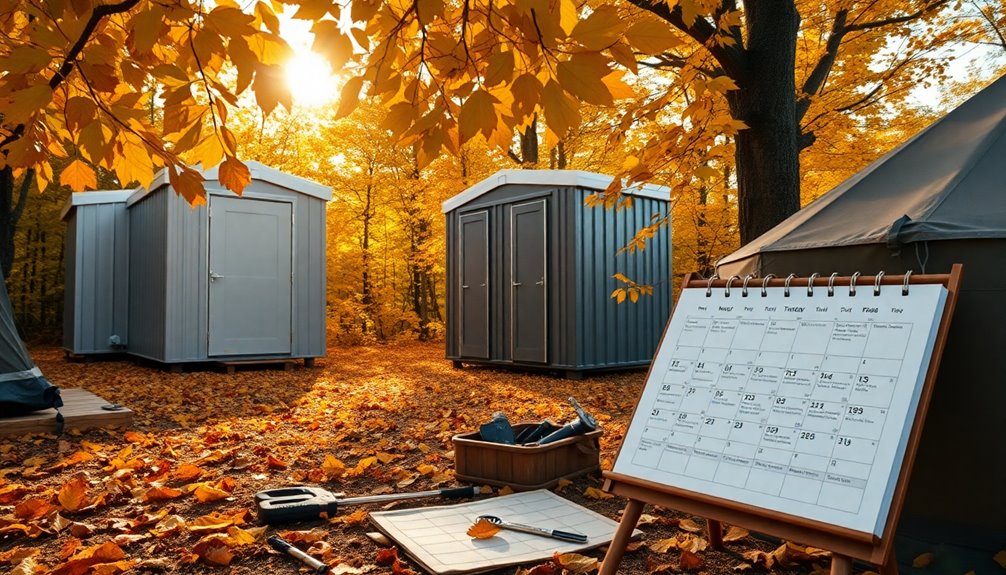
Maintaining your glamping portable restrooms is just as important as protecting them from cold weather. Establish a regular maintenance schedule that includes daily inspections, especially during peak usage times, to guarantee cleanliness and functionality.
Schedule pump-outs every 1-3 days for high-traffic events, preventing overflows and unpleasant odors. Implement a cleaning protocol that sanitizes surfaces and replenishes supplies like toilet paper and hand sanitizer, maintaining hygiene standards.
Monitor waste levels frequently, particularly in warm weather, to address sanitation concerns promptly. Finally, engage professional maintenance services for thorough inspections and seasonal preparations. Additionally, consider implementing regular monitoring of medication effectiveness for staff who assist with guest needs to ensure optimal care and support.
This proactive approach keeps your restrooms user-friendly and ready for any weather changes, guaranteeing a pleasant experience for your guests.
Emergency Stabilization Techniques Against High Winds

To guarantee your glamping portable restrooms remain stable during high winds, it's crucial to implement effective emergency stabilization techniques.
Start by securing your units with anchoring systems like stakes or weights to prevent tipping over. Utilize heavy-duty tarps or windbreaks to reduce wind exposure and minimize displacement risks.
- Keep guests safe and comfortable
- Protect your investment from damage
- Confirm a pleasant glamping experience
Additionally, place portable restrooms on stable, flat surfaces and regularly inspect your securing mechanisms before predicted high wind events.
Consider opting for units designed with aerodynamic shapes to reduce wind resistance. These steps will help you prevent issues and confirm your restrooms withstand gusty conditions.
Frequently Asked Questions
How to Winterize a Porta Potty?
To winterize a porta potty, you’ll want to start by completely emptying and cleaning the tank to prevent any freezing issues. Next, ensure that all water lines are drained to avoid any potential freeze damage. If you have luxury porta potty designs, consider using antifreeze solutions specifically made for portable toilets to further protect the components from low temperatures. Finally, cover the unit with a durable tarp or specialized cover to shield it from harsh winter weather.
After that, add a non-toxic antifreeze solution to lower the freezing point of waste.
Insulate the unit with a tarp or covering to keep heat inside.
Regularly check waste levels and schedule maintenance to avoid overflows.
Finally, consider placing the unit in a sheltered location to protect it from harsh winter conditions.
What Kind of Antifreeze Do You Put in a Portable Toilet?
When winter's chill sweeps in like a thief in the night, you've gotta protect your portable toilet.
You can use non-toxic antifreeze solutions to keep the holding tank sanitary and operational. Brine solutions work wonders for lowering freezing points, while methanol's extreme cold protection requires caution due to its flammability.
Don't forget magnesium chloride, effective down to -20°F.
Just remember to follow safety guidelines when mixing and applying these chemicals!
Conclusion
In preparing your glamping portable restrooms for changing weather, remember that nearly 30% of outdoor events face weather-related disruptions. By evaluating risks, choosing the right location, and employing effective insulation methods, you can keep your facilities functional and comfortable. Regular maintenance and emergency stabilization techniques will guarantee they withstand the elements. Don't let unpredictable weather dampen your guests' experience—be proactive and keep your restrooms ready for anything Mother Nature throws your way!
